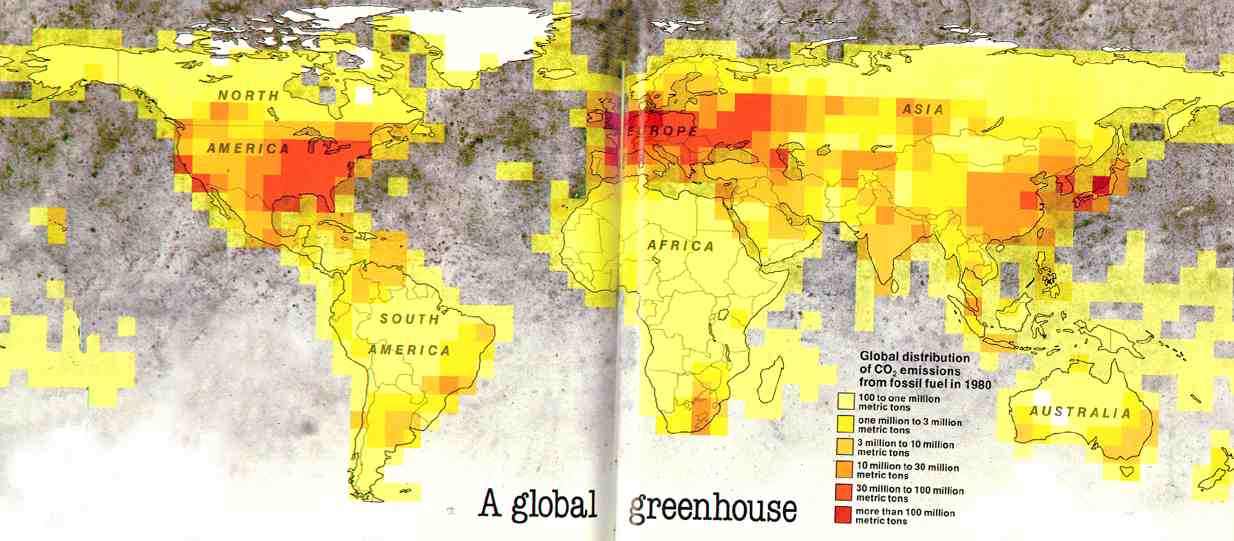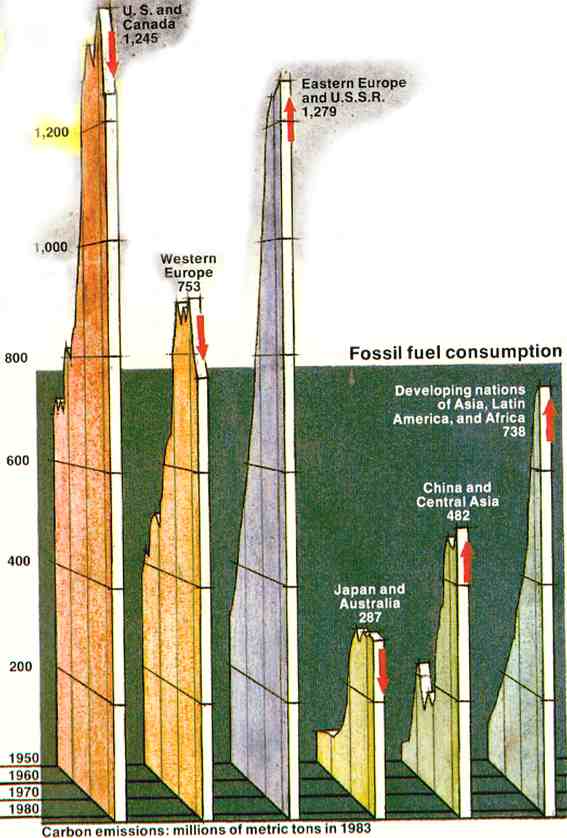previous page
next page
Can earth assimilate the additional 70 million tons of sulfur that we
release each year? What happens to plants that absorb the additional nitrogen
oxides (NOx) we create with our miniature lightning bolts inside car cylinders?
Can the atmosphere take on the extra load of carbon dioxide (C02), methane,
man-made ozone, and chlorofluorocarbon refrigerants that scientists say
could raise global temperatures by the greenhouse effect?

DURING the past two centuries carbon dioxide (CO2) in the atmosphere
has increased dramatically. The probable cause: the burning of fossil fuels
and the clearing and burning of forests by farmers. Nations of North
America and Europe, including the Soviet Union, emit the most CO2 since
they consume the greater part of the world's oil, coal, and gas (map, above).
But most burn less today than in 1980 (graph, below). By contrast, rapidly
developing nations of Asia, Latin America, and Africa continue to increase
fossil fuel consumption.

Scientists worry that the growing burden of C02 and other gases may
change earth's climate.  Like
panes of glass in a greenhouse, CO2 allows most solar radiation to penetrate
the atmosphere (right, top) but prevents part of the heat reradiated by
land and bodies of water from escaping into space (right, middle). As CO2
accumulates, enough heat may be trapped to gradually warm the atmosphere
(right, bottom).
Like
panes of glass in a greenhouse, CO2 allows most solar radiation to penetrate
the atmosphere (right, top) but prevents part of the heat reradiated by
land and bodies of water from escaping into space (right, middle). As CO2
accumulates, enough heat may be trapped to gradually warm the atmosphere
(right, bottom).
Researchers estimate that the earth's mean temperature could rise
1.5°C to 4.5°C (2.5°F to 7.5°F) by the middle of the next
century if greenhouse gases continue to increase at the current rate. That
would make the atmosphere warmer than it has been at any time during the
past 100,000 years. Global rainfall patterns could shift, bringing heavy
rains to previously arid regions such as the Sahel and droughts to productive
farmlands such as the U.S. Midwest.
The impact could be even greater at the Poles, where mean temperatures
might rise as much as 10°C (18°F). If the West Antarctic ice sheet
melted, as it did during a previous period 120,000 years ago, ocean levels
could gradualy rise as much as 15 or 20 feet, flooding many cities and
farm regions.
So far there has been no clear evidence that a warming trend has
begun. But scientists warn that the atmosphere would require thousands
of years to recover from a mean global warmup of 1.5° to 4.5° C.
next page


 Like
panes of glass in a greenhouse, CO2 allows most solar radiation to penetrate
the atmosphere (right, top) but prevents part of the heat reradiated by
land and bodies of water from escaping into space (right, middle). As CO2
accumulates, enough heat may be trapped to gradually warm the atmosphere
(right, bottom).
Like
panes of glass in a greenhouse, CO2 allows most solar radiation to penetrate
the atmosphere (right, top) but prevents part of the heat reradiated by
land and bodies of water from escaping into space (right, middle). As CO2
accumulates, enough heat may be trapped to gradually warm the atmosphere
(right, bottom).